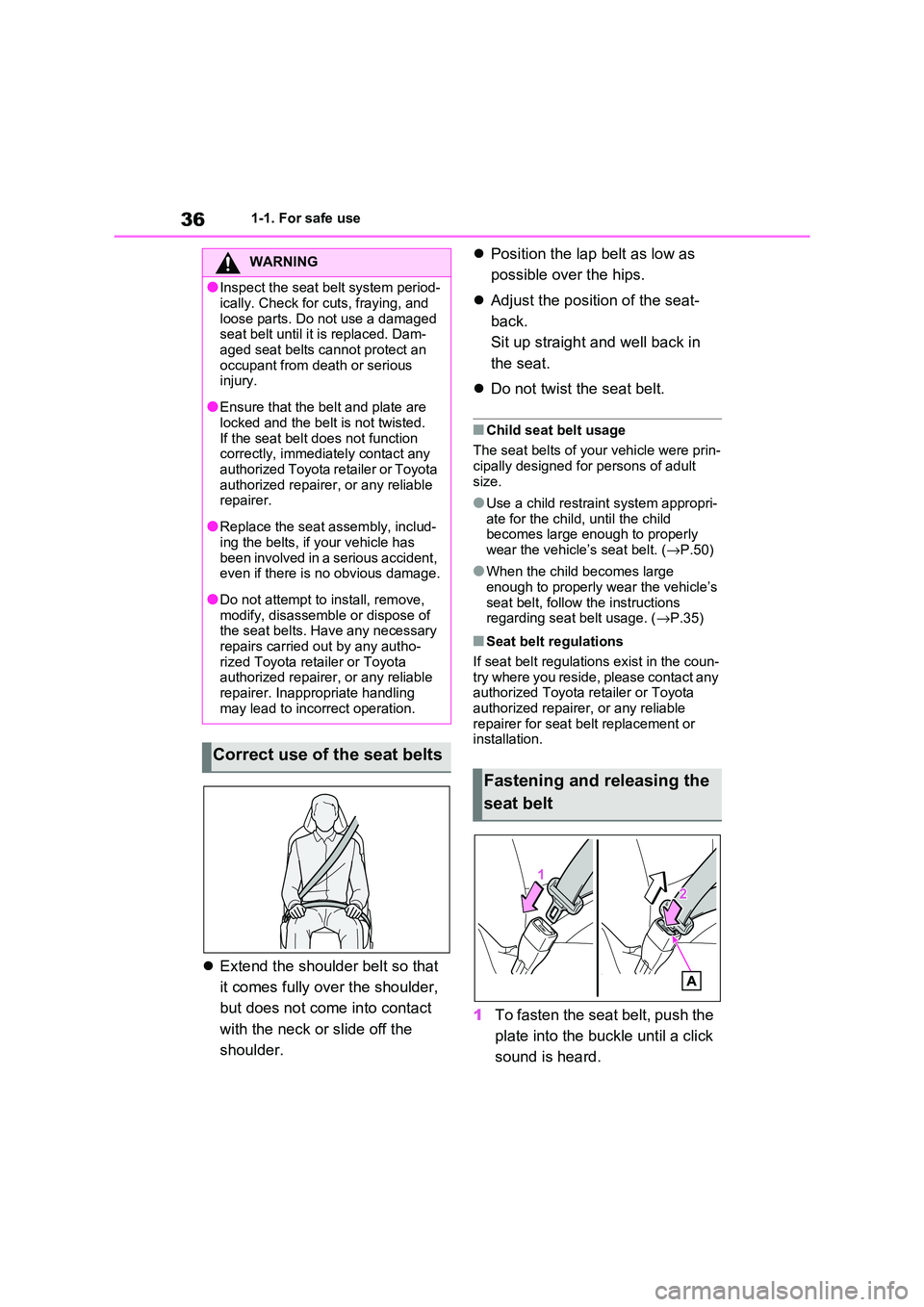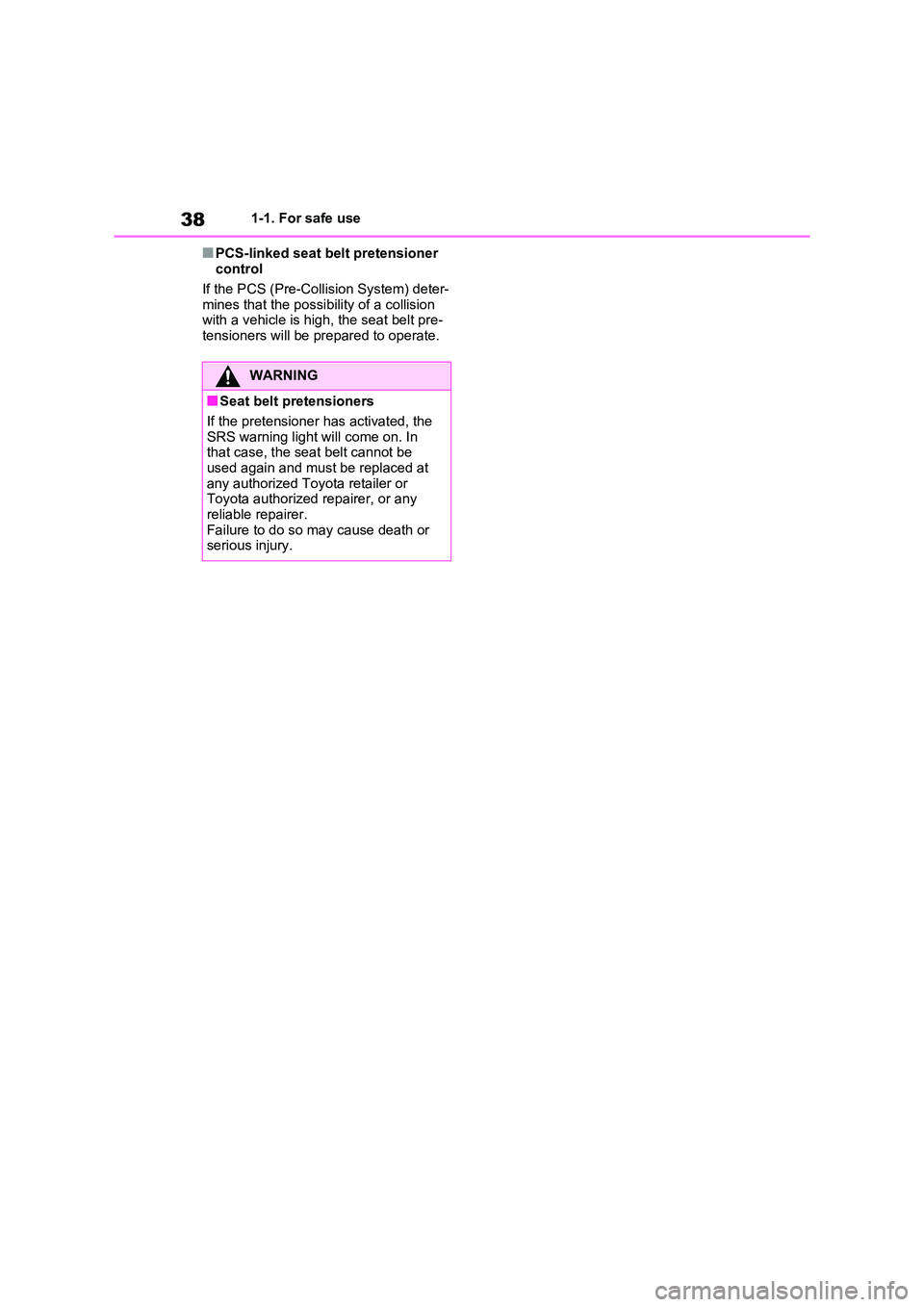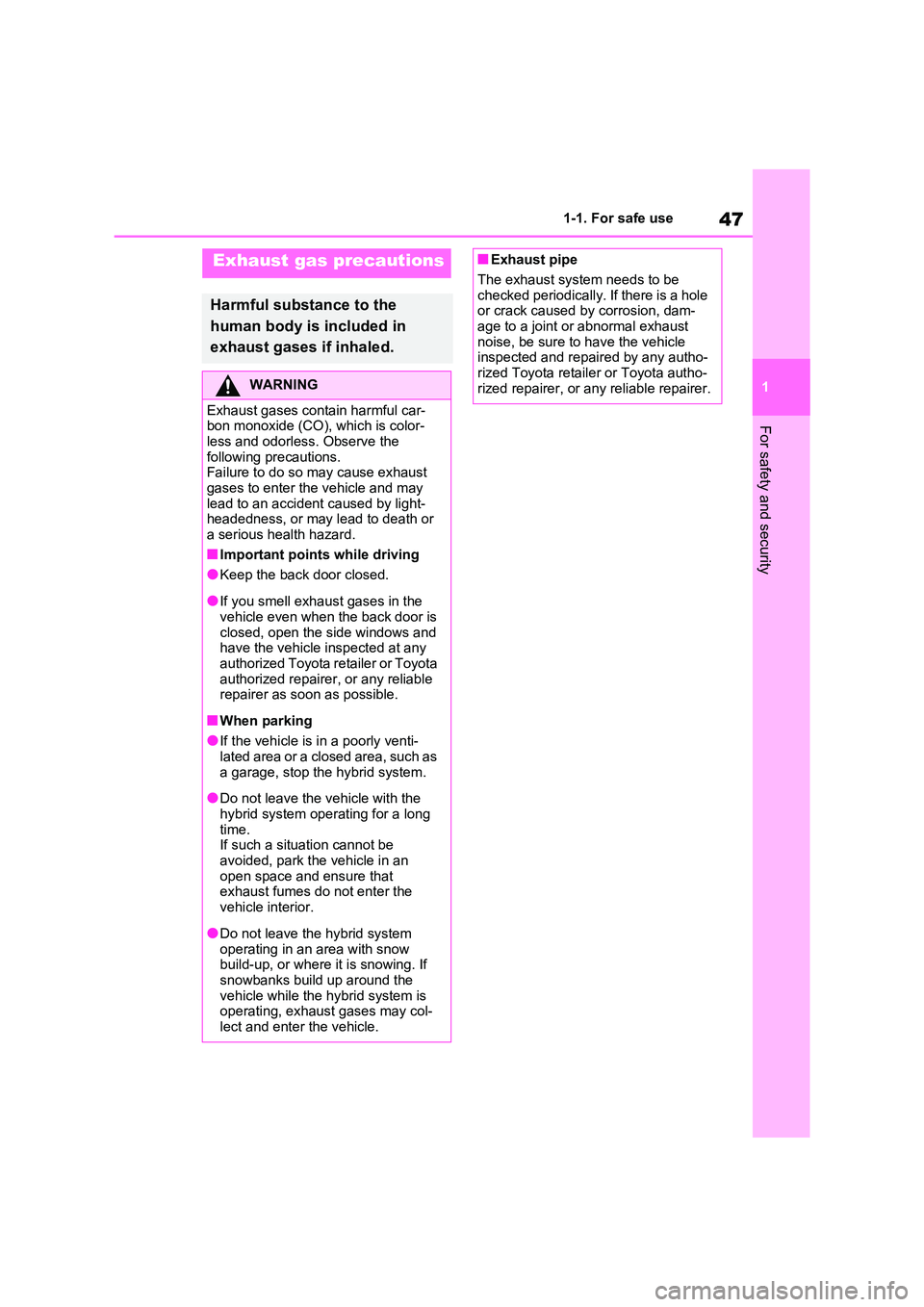2021 TOYOTA RAV4 PHEV warning
[x] Cancel search: warningPage 38 of 666

361-1. For safe use
Extend the shoulder belt so that
it comes fully over the shoulder,
but does not come into contact
with the neck or slide off the
shoulder.
Position the lap belt as low as
possible over the hips.
Adjust the position of the seat-
back.
Sit up straight and well back in
the seat.
Do not twist the seat belt.
■Child seat belt usage
The seat belts of yo ur vehicle were prin- cipally designed for persons of adult
size.
●Use a child restraint system appropri -
ate for the child, until the child
becomes large enough to properly wear the vehicle’s seat belt. ( →P.50)
●When the child becomes large enough to properly wear the vehicle’s
seat belt, follow the instructions
regarding seat belt usage. ( →P.35)
■Seat belt regulations
If seat belt regulati ons exist in the coun-
try where you reside, please contact any
authorized Toyota r etailer or Toyota authorized repairer, or any reliable
repairer for seat belt replacement or
installation.
1 To fasten the seat belt, push the
plate into the buckle until a click
sound is heard.
WARNING
●Inspect the seat belt system period -
ically. Check for cu ts, fraying, and
loose parts. Do not use a damaged seat belt until it is replaced. Dam -
aged seat belts c annot protect an
occupant from death or serious injury.
●Ensure that the be lt and plate are
locked and the belt is not twisted. If the seat belt does not function
correctly, immediately contact any
authorized Toyota retailer or Toyota authorized repairer, or any reliable
repairer.
●Replace the seat assembly, includ -
ing the belts, if your vehicle has
been involved in a serious accident, even if there is no obvious damage.
●Do not attempt to install, remove, modify, disassemble or dispose of
the seat belts. Have any necessary
repairs carried out by any autho - rized Toyota ret ailer or Toyota
authorized repairer, or any reliable
repairer. Inappropriate handling may lead to incorrect operation.
Correct use of the seat belts
Fastening and releasing the
seat belt
Page 40 of 666

381-1. For safe use
■PCS-linked seat belt pretensioner
control
If the PCS (Pre -Collision System) deter-
mines that the possibility of a collision
with a vehicle is high, the seat belt pre - tensioners will be prepared to operate.
WARNING
■Seat belt pretensioners
If the pretensioner has activated, the
SRS warning light will come on. In that case, the seat belt cannot be
used again and must be replaced at
any authorized Toyo ta retailer or Toyota authorized repairer, or any
reliable repairer.
Failure to do so m ay cause death or serious injury.
Page 42 of 666

401-1. For safe use
Can help protect prim arily the head of occupants in the outer seats
■SRS airbag system components
Front impact sensors
Airbag manual on-off switch
Front passenger airbag
Side impact sensors (front door)
Curtain shield airbags
Seat belt pretensioners and fo rce limiters (front seats)
Side impact sensors (front)
Side airbags
Side impact sensors (rear)
Seat belt pretensioners and force limiters (outboard rear seats)
Driver airbag
Knee airbag
SRS warning light
Airbag sensor assembly
A
B
C
D
E
F
G
H
I
J
K
L
M
N
Page 45 of 666

43
1
1-1. For safe use
For safety and security
repairer as soon as possible.
●Any of the SRS airbags have been
inflated.
●The front of the vehicle is damaged or
deformed, or was involved in an acci -
dent that was no t severe enough to cause the SRS front airbags to inflate.
●A portion of a door or its surrounding area is damaged, deformed or has
had a hole made in it, or the vehicle
was involved in an accident that was not severe enough to cause the SRS
side and curtain shield airbags to
inflate.
●The pad section of the steering wheel,
dashboard near the front passenger airbag or lower portion of the instru -
ment panel is scratched, cracked, or
otherwise damaged.
●The surface of the seats with the SRS
side airbag is scratched, cracked, or
otherwise damaged.
●The portion of the front pillars, rear pil -
lars or roof side rail garnishes (pad- ding) containing the SRS curtain
shield airbags inside is scratched,
cracked, or otherwise damaged.
WARNING
■SRS airbag precautions
Observe the following precautions
regarding the SRS airbags.
Failure to do so m ay cause death or serious injury.
●The driver and all passengers in the
vehicle must wear their seat belts properly.
The SRS airbags are supplemental
devices to be used with the seat belts.
Page 46 of 666

441-1. For safe use
WARNING
●The SRS driver airbag deploys with
considerable force, and can cause
death or serious injury especially if the driver is very close to the air-
bag.
Since the risk zone for the driver’s air -
bag is the first 50 - 75 mm (2 - 3 in.) of
inflation, placing yourself 250 mm (10
in.) from your drive r airbag provides
you with a clear margin of safety. This
distance is measured from the center
of the steering whee l to your breast-
bone. If you sit less than 250 mm (10
in.) away now, you can change your
driving position in several ways:
• Move your seat to the rear as far as
you can while still reaching the ped -
als comfortably.
• Slightly recline the back of the seat.
Although vehicle designs vary, many drivers can achieve the 250
mm (10 in.) distanc e, even with the
driver seat all th e way forward, sim- ply by reclining the back of the seat
somewhat. If reclin ing the back of
your seat makes i t hard to see the road, raise yourself by using a firm,
non-slippery cushion, or raise the
seat if your vehicle has that feature.
• If your steering wheel is adjustable,
tilt it downwa rd. This points the air- bag toward your chest instead of
your head and neck.
The seat should be adjusted as rec - ommended above, while still main -
taining control of the foot pedals,
steering wheel, and your view of the instrument panel controls.
●The SRS front passenger airbag also deploys with considerable
force, and can caus e death or seri-
ous injury especially if the front pas - senger is very clo se to the airbag.
The front passenger seat should be
as far from the airbag as possible with the seatback adjusted, so the
front passenger sits upright.
●Improperly seated and/or restrained
infants and children can be killed or
seriously injured by a deploying air - bag. An infant or child who is too
small to use a seat belt should be
properly secured using a child restraint system. Toyota strongly
recommends that all infants and
children be placed in the rear seats of the vehicle and properly
restrained. The rear seats are safer
for infants and children than the front passenger seat. ( →P.50)
●Do not sit on the edge of the seat or lean against the dashboard.
●Do not allow a child to stand in front of the SRS front passenger airbag
unit or sit on the knees of a front
passenger.
●Do not allow the front seat occu-
pants to hold items on their knees.
Page 47 of 666

45
1
1-1. For safe use
For safety and security
WARNING
●Do not lean against the door, the
roof side rail or the front, side and
rear pillars.
●Do not allow anyone to kneel on the
passenger seat toward the door or
put their head or hands outside the vehicle.
●Do not attach anything to or lean anything against areas such as the
dashboard, steering wheel pad and
lower portion of the instrument panel.
These items can become projec -
tiles when the SRS driver, front passenger and knee airbags
deploy.
●Do not attach anything to areas such as a door, windshield, side
windows, front or rear pillar, roof
side rail and assist grip. (Except for the speed limit label →P.585)
●Do not hang coat hangers or other hard objects on th e coat hooks. All
of these items c ould become pro-
jectiles and may cause death or serious injury, should the SRS cur -
tain shield airbags deploy.
●If a vinyl cover is put on the area
where the SRS knee airbag will
deploy, be sure to remove it.
●Do not use seat a ccessories which
cover the parts wh ere the SRS side airbags inflate as they may interfere
with inflation of t he SRS airbags.
Such accessories may prevent the SRS side airbags from activating
correctly, disabl e the system or
cause the SRS side airbags to inflate accidentally, resulting in
death or serious injury.
●Do not strike or apply significant
levels of force to the area of the
SRS airbag components or the front doors.
Doing so can cause the SRS air -
bags to malfunction.
●Do not touch any of the component
parts immediately after the SRS air -
bags have deployed (inflated) as they may be hot.
Page 48 of 666

461-1. For safe use
WARNING
●If breathing becomes difficult after
the SRS airbags have deployed,
open a door or side window to allow fresh air in, or lea ve the vehicle if it
is safe to do so. Wash off any resi-
due as soon as possible to prevent skin irritation.
●If the areas where the SRS airbags
are stored, such as the steering wheel pad and front and rear pillar
garnishes, are damaged or
cracked, have them replaced by any authorized Toyota retailer or
Toyota authorized repairer, or any
reliable repairer.
■Modification and disposal of SRS
airbag system components
Do not dispose of your vehicle or per -
form any of the following modifica -
tions without c onsulting any authorized Toyota ret ailer or Toyota
authorized repairer, or any reliable
repairer. The SRS airbags may mal - function or deploy (inflate) acciden-
tally, causing death or serious injury.
●Installation, removal, disassembly and repair of the SRS airbags
●Repairs, modifications, removal or replacement of the steering wheel,
instrument panel, d ashboard, seats
or seat upholstery, front, side and rear pillars, roof side rails, front
door panels, front door trims or front
door speakers
●Modifications to the front door panel
(such as making a hole in it)
●Repairs or modifications of the front
fender, front bumper, or side of the occupant compartment
●Installation of a grille guard (bull bars, kangaroo bar, etc.), snow
plows or winches
●Modifications to t he vehicle’s sus-
pension system
●Installation of ele ctronic devices such as mobile two-way radios (RF-
transmitter) and CD players
Page 49 of 666

47
1
1-1. For safe use
For safety and security
Exhaust gas precautions
Harmful substance to the
human body is included in
exhaust gases if inhaled.
WARNING
Exhaust gases contain harmful car -
bon monoxide (CO), which is color -
less and odorless. Observe the following precautions.
Failure to do so may cause exhaust
gases to enter the vehicle and may lead to an acciden t caused by light-
headedness, or may lead to death or
a serious health hazard.
■Important points while driving
●Keep the back door closed.
●If you smell exhaust gases in the
vehicle even when the back door is
closed, open the side windows and have the vehicle inspected at any
authorized Toyota retailer or Toyota
authorized repairer, or any reliable repairer as soon as possible.
■When parking
●If the vehicle is in a poorly venti -
lated area or a closed area, such as
a garage, stop t he hybrid system.
●Do not leave the vehicle with the
hybrid system opera ting for a long time.
If such a situation cannot be
avoided, park the vehicle in an open space and ensure that
exhaust fumes do not enter the
vehicle interior.
●Do not leave the hybrid system
operating in an area with snow build-up, or where it is snowing. If
snowbanks build up around the
vehicle while the hybrid system is operating, exhaust gases may col -
lect and enter the vehicle.
■Exhaust pipe
The exhaust system needs to be
checked periodically. If there is a hole
or crack caused b y corrosion, dam- age to a joint or abnormal exhaust
noise, be sure to have the vehicle
inspected and repai red by any autho- rized Toyota retaile r or Toyota autho-
rized repairer, or any reliable repairer.